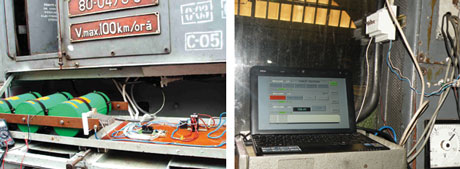Energy-Optimized Electrical Systems for Land Transport Using Batteries and Supercapacitors: TRANS-SUPERCAP
by Paul Borza, Ana Maria Puscas and Marius Carp
The ‘TRANS-SUPERCAP’ project plans to optimize the energy use, operation, reliability and availability of locomotives and automobiles by redesigning the electric starting systems of the internal combustion engine. This is done using combinations of batteries and ‘stacked’-type supercapacitors provided by new nanotechnology.
It is known that energy storage and mobile energy sources are critical elements for powered systems. Existing energy storage devices do not satisfy all modern requirements, especially when a device must demonstrate high performance and be energy efficient. The TRANS-SUPERCAP national research project, currently under development at the ‘Transilvania’ University of Brasov, will demonstrate that a satisfactory compromise can be reached by combining energy sources (batteries), rapid-release storage devices (high voltage [9F/110V] aqueous stacked supercapacitors) and an intelligent control system.
This project proposes the research and development of an, energy-efficient electric starting systems with a long lifespan. These will use a combination of battery and supercapacitors, adjusted according to the load, using power-switching devices controlled by an embedded system. This latter system will control the power flow transfer between the source and the load by monitoring and anticipating the demand from the load side, in order to optimize the energy efficiency of the whole system. This implementation allows not only energy and material consumption but also environmental pollution to be reduced.
The project will work toward a deeper understanding of the transient phenomena occurring into the whole system, in energy and power sources, ICE (internal combustion engine), and also the DC starter motors. The project will develop integrated model sources, an electric starter motor, ICE and control systems and also a methodology for system design which will permit its rapid adaptation to any type of vehicle.
Most vehicles currently use lead-acid (L-A) batteries as power supplies for starting their ICEs, after which the running of the ICE provides the electricity necessary for vehicles. The starting process is critical because it requires significant peaks of power from batteries. Assessing the damage caused by starting shocks is a difficult task. Thus, all the design methodologies for staring systems of vehicles take into account an over-dimensioning of the batteries. To protect and also to assure a reliable starting process, the designer over-dimensions the battery, that means they increase the battery capacity in order to assure the maximum current demanded by DC starting motor and at the same time try to prevent the deep discharge which would significantly reduce its lifetime.
Progress in nanotechnology has brought with it important improvements in supercapacitors, which are now better able to fulfill requirements related to maximum current, power and energy density. It therefore appears mandatory to introduce an energy management system developed for mobile applications that also assure the harmonization of the time constants between the different power supplies or storage devices.
Combined solutions involving L-A batteries and supercapacitors appear to be feasible and an optimum compromise in terms of energy economy, materials, size and cost (including maintenance costs). While low-temperature starts are a problem for batteries, in the case of the combined solution, the battery will be protected and ICE starting will be significantly improved. By providing intelligent and adaptive switching of the electric starter motor between supercapacitor and battery, the characteristic response of the system can be optimized both in the starting phase and in the charging phase of the batteries.

An electric starting system installed on locomotive. The system include two components: the locomotive driver console (left) and the embedded systems dedicated for the main subsystems. The picture on the right shows the box of supercapacitors and the afferent control systems linked to console by an Ethernet bus.
In the specific case of locomotives, the most important requirements are the reliability and availability of the starting system, low weight, and the cost and fuel consumption. Our energy management system optimally satisfies all these necessities:
- the mass and volume of the power supply have been reduced by more than half
- the application does not need balancing resistors for component cells of high voltage supercapacitor
- this type of supercapacitors is ‘stacked’ with aqueous electrolyte (KOH) and doesn’t generate poisonous gases during functioning
- the devices operate between -40ºC and +80 ºC, maintaining a very low ESR (Equivalent Series Resistance) over the entire temperature range assuring a very high reliability of starting process
- the storage devices are compact and ecologically sound, with a very high dynamic stability (tested at sinus 4 g(ms-2) mechanical vibration stress for more than 1000 hours with no damage); the devices accept more than 10 g acceleration shock without damage
- the system presents a high power density (by mass and volume).
The starting system described here has been successfully tested over a one-year period in collaboration with the Romanian Railways Company. The successful results of the tests, with implications for increased reliability and reduced costs, encouraged the application of stacked supercapacitors utilizing aqueous electrolyte to improve the starting systems of diesel locomotives and other diesel engine vehicles.
The energy management system which has been developed allows switching between the two energy sources (supercapacitors and batteries) to occur automatically, depending on the temperature and oil pressure within the ICE.
We are encouraged by these results, and are now working on developments such as dynamic retrieval of breaking energy on vehicles, mechatronic actuator systems, and active filters used to improve energy grid parameters. At the same time, energy sources endowed with intelligent controlled storage devices will lead to future architectural forms for energy sources, especially for mobile types. By embedding the control in each combined energy cell and developing the hierarchical architecture, the complexity of bidirectional energy transfer can be better mastered to give a direct improvement in energy efficiency.
Please contact:
Paul Borza, Ana Maria Puscas and Marius Carp
Transilvania University of Brasov, Romania
E-mail:










